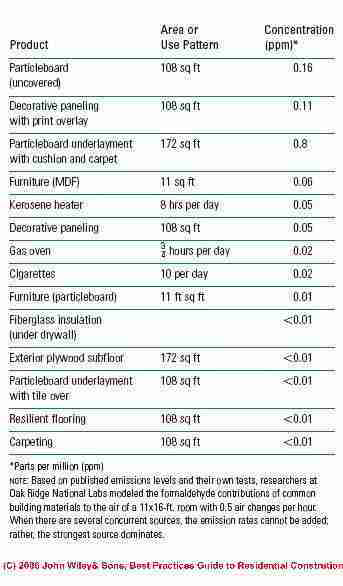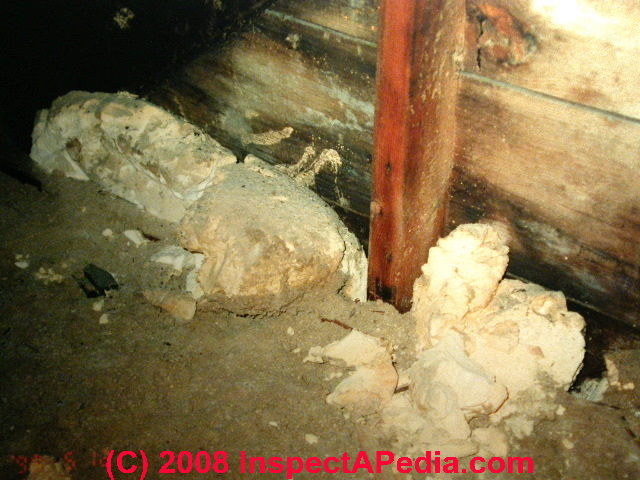 Formaldehyde Gas & Outgassing Hazards In Buildings
Formaldehyde Gas & Outgassing Hazards In Buildings
Where does formaldehyde come from, what levels are hazardous, how do we reduce the hazard?
- POST a QUESTION or COMMENT about the sources of formaldehyde gas hazards, odors, or smells in buildings
Formaldehyde gas exposure health risks in homes, offices, other buildings:
This article describes the health risks of exposure to formaldehyde gas in air or water, and we describe the proper steps to detect, measure, and remove formaldehyde gas and formaldehyde gas emitting building products in order to improve indoor air quality in homes.
We include a table of common levels of formaldehyde emissions found outdoors and inside buildings combined with common residential exposure limits for formaldehyde (HCHO).
InspectAPedia tolerates no conflicts of interest. We have no relationship with advertisers, products, or services discussed at this website.
- Daniel Friedman, Publisher/Editor/Author - See WHO ARE WE?
A Guide to Reducing Exposure to Formaldehyde Hazards in Indoor Air
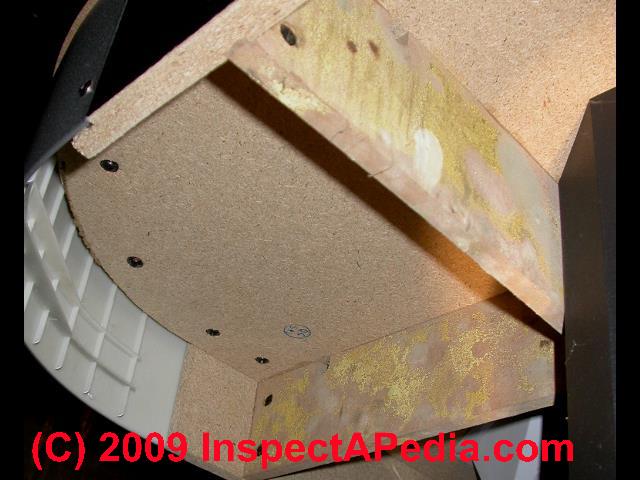 Here we give the following: sources of formaldehyde gas or odors in buildings, a table of concentrations of formaldehyde outdoors & indoors compared with recommended exposure limits for residential buildings, formaldehyde gas exposure limits, and advice on how to reduce formaldehyde exposure levels in a building
Here we give the following: sources of formaldehyde gas or odors in buildings, a table of concentrations of formaldehyde outdoors & indoors compared with recommended exposure limits for residential buildings, formaldehyde gas exposure limits, and advice on how to reduce formaldehyde exposure levels in a building
Recent formaldehyde concerns inlcuding formaldehyde levels in FEMA trailers provided as temporary housing for Hurricane Katrina victims and in other mobile homes.
Article Contents
- FORMALDEHYDE CONCENTRATIONS & LIMITS
- FORMALDEHYDE EXPOSURE HEALTH EFFECTS
- FORMALDEHYDE SOURCES in BUILDINGS
- FORMALDEHYDE LEVELS vs BUILDING AIR CHANGE RATE ACH
- FORMALDEHYDE INFORMATION INDEX
Photo above: mold contaminated particleboard countertop materials.
This countertop was a source of both formaldehyde offgassing and two species of Aspergillus sp. mold.
Table of Formaldehyde Concentrations (Levels) Exposures & Recommended Exposure Limits
Formaldehyde, HCHO, or formalin is a colorless gas, a ubiquitous volatile organic compound (VOC) that occurs in nature, is a combustion product, and is widely used in building products, often in the form of resins used in glues or binders.
[Click to enlarge any image]
Table 7-7 given above left lists the Contributions of Formaldehyde to Room Air from various building materials and activities. Additional sources of formaldehyde in buildings have been reported since that table was drawn, including product outgassing discussed in detail at
at FORMALDEHYDE GAS SOURCES in BUILDINGS
It is normal for indoor levels of formaldehyde to be above outdoor levels, and high formaldehyde concentrations may be found in some buildings, typically as a result of offgassing of formaldehyde from a variety of building products and furnishings.
Salthammer (2010) reported on the range of formaldehyde concentrations in both outdoor air and in building indoor air, from which we excerpt and into which we expand with formaldehyde level notes from other sources:
Common Concentrations of Formaldehyde (HCHO) in Indoor & Outdoor Air1 |
||
| Type of Air / Location | Approximate Formaldehyde Level in Parts per Billion (PPB) | Comments |
| Remote Air | 0.1 - 1 ppb | |
| Rural Air | 0.5 - 1.5 ppb | |
| Urban Air | 1.25 - 50 ppb | |
| Outdoor Air2 | < 1 ppb - 6.5 ppb [Median = 1.7 ppb] |
|
| Normal Indoor Air | 15 - 100 ppb | |
California EPA (OEHHA) Recommended Indoor Chronic Exposure Limit (residential) (REL)3 & |
7.3 ppb | To protect against respiroatory system effects3 |
| California OEHHA3 | 30 ppb | Decreased lung function in children |
| Canadian Residential IAQ Recommended Indoor 8-Hour Exposure Limit | 40 ppb | Respiratory symptoms may occur in children |
| California EPA (OEHHA) Recommended Indoor Acute 1-hour Exposure Limit (residential) Acute Reference Exposure Level (REL)3 |
45 ppb | Set to protect against sensory & eye irritation |
| California OEHHA3 | 60-120 ppb | Children more likely to have asthma or chronic bronchitis |
| Canadian Residential IAQ Recommended Indoor 1- Hour Exposure Limit | 100 ppb | Eye irritation may occur |
| US EPA | 100 ppb | Respiratory irritation in most adults |
| California Study of Recently-Built Homes2 | 4 - 120 ppb [Median = 29 ppb] |
|
| Polluted Indoor Air | 100 - 400 ppb | |
| Extreme Conditions | > 400 ppb | |
Notes to the table above
1. Salthammer (2010)
2. Offermann (2009)
3. California OEHHA - Office of Environmental Health Hazard Assessment, cited by Offermann (2010).
SeeReferences or Citations for citation details.
In sum it would be unusual to find indoor building air with a formaldehyde concentration below 1 ppb, and when the indoor formaldehyde concentration is above 100 ppb further investigation may be warranted.
See FORMALDEHYDE GAS EXPOSURE LIMITS for a table of Health Effects of Exposure to Formaldehyde and for formaldehyde exposure standards around the world.
Formaldehyde appears in many building components or contents such as fabrics, finishes, furniture, furnishings, plywood, OSB, MDF, particle board and other wood products. Formaldehyde-resin-containing wood panel type products are in turn used in the construction of cabinets, laminate flooring, shelving, wall & roof sheathing, subflooring or underlayment: all products having widespread use in buildings.
At above-left is an example of mold-contaminated particleboard used as the structure for a kitchen countertop.
Formaldehyde or resin containing it appears as well even in paper, pulp, and some insulations such as flass wool and rock wool. HCHO is so widely used because of its desirable
properties and its low cost. It is thus a valuable compound that is not easily replaced in thse applications.
Because formaldehyde is a simple but highly-reactive organic chemical compound, nearly all products made using formaldehyde outgas or "offgass" formaldehyde to some extent. Some of these can contribute to indoor air quality problems. Formaldehyde outgassing from products typically is highest when the products are new and decreases significantly over time. The rate of decrease in formaldehyde outgassing also depends on the product composition and on conditions where it is found.
The level and duration of formaldehyde release from a product depends on quite a few variables discussed in this article series including temperature, physical movement or cutting, moisture or humidity level, how the product was made or how it has been coated or sealed.
Formaldehyde is used to add permanent press qualities to clothing and drapes, as a preservative in many paints and coatings, and as the adhesive resin in some carpeting, fiberglass insulations, and pressed wood products. It is also a product of combustion found in tobacco smoke and the fumes from gas stoves and other unvented combustion.
By far, the most significant source of formaldehyde in homes today is pressed wood products (also referred to as composite wood products or particle board or medium density fiberboard or MDF) made with urea- formaldehyde resins.
These products include particle board, interior hardwood paneling, some laminate flooring products and medium-density fiberboard (MDF), which has the highest concentration of urea- formaldehyde of any pressed wood product.
The relative
contributions of new materials to a single room are shown
in Table 7-7, above-left.
See Lumber Liquidators LAMINATE FLOORING FORMALDEHYDE CONCERNS?
Formaldehyde is normally present at low levels, usually below 0.03 ppm both indoors and outdoors. However, buildings with high levels of pressed wood products can have higher indoor levels. For example, many manufactured homes have levels well above 0.03 ppm, due to their relatively small volume and large surface area of formaldehyde emitting materials.
HUD standards that limit the formaldehyde emissions of materials used in manufactured housing are designed to bring the ambient level to below 0.40 ppm, still over four times the 0.10 ppm limit recommended by most health and standards organizations, including ASHRAE and ANSI.
No standard exists for site- built homes.
Health Effects of Formaldehyde
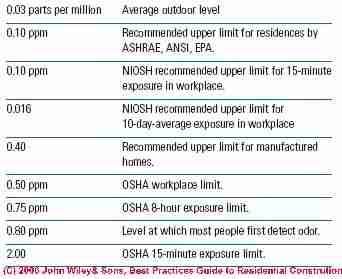 Sensitivity to formaldehyde varies
widely. At low levels in buildings formaldehyde has virtually no smell or "odor".
Sensitivity to formaldehyde varies
widely. At low levels in buildings formaldehyde has virtually no smell or "odor".
At levels between 0.40 and 3.0 ppm, most people experience watery eyes, burning sensations in the nose or throat, nausea, and difficulty breathing. Most people detect the chemical’s pungent odor at about 0.80 ppm, but many can smell it at concentrations as low as .05 ppm.
Watch out: there may be health risks from exposure to formaldehyde even if there is no formaldehyde-related odor detected or reported by building occupants.
Formaldehyde been identified as a human cancer-causing agent (IARC, 2004).
Formaldehyde & Asthma
High concentrations of formaldehyde may trigger asthma attacks, and there is strong evidence that some people can develop a sensitivity to formaldehyde from exposure.
Formaldehyde as a Carcinogen
Formaldehyde has been conclusively linked to nasal cancer in rats, while human studies have suggested a link to nose and throat cancer in humans, but are not conclusive. And in fact
Based on the current evidence the EPA and the International Agency for Research in Cancer consider formaldehyde a probable carcinogen prompting the lower workplace limits suggested by the National Institute for Occupational Safety and Health (NIOSH) (see the Formaldehyde Exposure Limits in Table 7-8 at left).
More information is at FORMALDEHYDE EXPOSURE IN HOMES:A REFERENCE FOR STATE OFFICIALS TO USE IN DECISION-MAKING [PDF], U.S. CDC
- - Above material was adapted with permission from Best Practices Guide to Residential Construction (Steve Bliss, J Wiley & Sons) . Updated through January 2014.
Common Sources of Formaldehyde Gas in buildings
Formaldehyde is a ubiquitous volatile organic compound (VOC) that occurs in nature and is widely used in building products, finishes, and furnishings because of its desirable properties and low cost. Nearly all products made with formaldehyde outgas to some extent, but only a few contribute significantly to indoor air problems.
A significant source of indoor formaldehyde emissions in many buildings is found in flooring, furnishings, shelving or other products making use of medium density fiberboard (MDF) but note that the levels of outgassing among even these products may vary widely depending on the manufacturing method and source, product age, building and building environment factors such as temperature, humidity, ventilation, air circulation and other considerations.
Formaldehyde is used to add permanent press qualities to clothing and drapes, as a preservative in many paints and coatings, and as the adhesive resin in some carpeting, fiberglass insulations, and pressed wood products. It is also a product of combustion found in tobacco smoke and the fumes from gas stoves and other unvented combustion.
Table 7-7 at left lists the Contributions of Formaldehyde to Room Air from various building materials and activities.
Details: for a comphrehensive list of sources of formaldehyde in buildings have been reported since that table was drawn, including product outgassing, see
FORMALDEHYDE GAS SOURCES in BUILDINGS
Relationship Between Building Air Change Rate and Formaldehyde Levels
Offermann and Kincaid writing for The Synergist (AIHA) reported in 2010 that while most building codes require at least one air change per hour (ACH) in office buildings, residential ACH rates have had less attention.
The authors explain that as homes have been made increasingly air-tight (to save energy) the home ventilation rate can be much less than the commercial or industrial standard and may be as low as 0.1 ACH.
(Offermann 2010 & Offermann 2018 seeReferences or Citations )
The authors note that a 2005 IAQ study found that 67% of California homes had a fresh air intake or ACH rate below the 2006 Califorina required rate of 0.35 ACH. The same study found that indoor levels of formaldehyde also exceeded the California recommendations.
Still more remarkably for people who have not been following research concerning the safety of exposure to formaldehyde, all of the California homes studied were found to sport formaldehyde at levels defined as the California No Significant Risk Level (NSRL) for cancer.
California Building Standards (Title 24) now require a minimal 0.15 ACH provision of outdoor air for homes built after 1 January 2010.
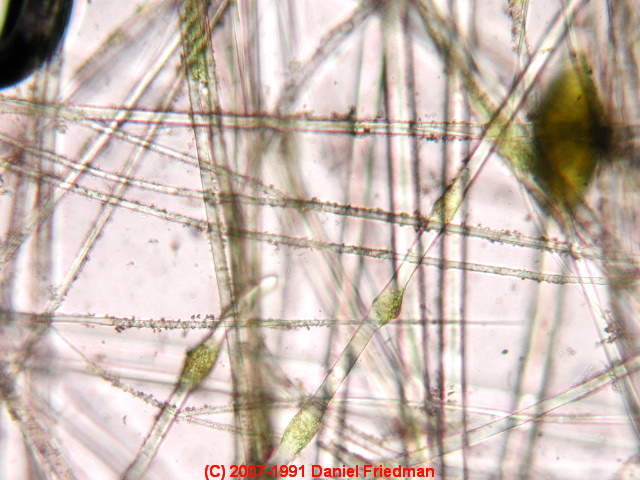 The authors propose that the most likely source of this formaldehyde indoors is composite wood products made with formaldehyde resins
The authors propose that the most likely source of this formaldehyde indoors is composite wood products made with formaldehyde resins
(see FORMALDEHYDE GAS SOURCES in BUILDINGS) combined with the low fresh air exchange rate associated with these low ACH numbers.
In the 2010 Synergist article Kincaid reportind finding higher than usual levels of formaldehyde in homes in Los Altos CA (60-120 ppb) with still higher levels of several hundred ppb of formaldehyde in "normally closed" spaces such as closets and pantries.
Kincaid noted that "In nearby San Jose and surrounding communities, formaldehyde concentrations in homes was typically between 40 and 80 ppb." 3 The authors pose that the higher levels of formaldehyde in Los Altos homes was associated with efforts to promote green construction and tighter buildings - all of the homes she had tested were "GreenPoint" rated.
Further studies reported by the authors, finding higher concentrations (50-80 ppb) of formaldehyde in Indio CA homes built in 2007, suggested that elevated levels of formaldehyde in wall cavities were due to two formaldehyde emitters: drywall and fiberglass insulation [presumably the binder resins typically used with formaldehyde - Ed.].
Indeed binder resin such as the yellow resin in our lab photo at above left, is what usually gives fiberglass insulating products their characteristic color - glass fibers themselves are generally hyaline or colorless.
The authors concluded [and we agree] that the essential cause of high indoor formaldehyde levels in buildings is the combination of formaldehyde offgassing sources such as particleboard or some brands of flooring and other products combined with low ACH or fresh air or make-up air in buildings.
Also see FORMALDEHYDE in LAMINATE FLOORING
and
see VENTILATION, BALANCED for advice on using heat-recovery ventilation to improve indoor air quality while preserving low energy cost designs in buildings.
...
Reader Comments, Questions & Answers About The Article Above
Below you will find questions and answers previously posted on this page at its page bottom reader comment box.
Reader Q&A - also see RECOMMENDED ARTICLES & FAQs
Smelling some smell or offgassing coming from the space around the pipes under the bathroom cabinet.
I have been smelling something coming from the space around the pipes under the bathroom cabinet. Not only does a flashlight illuminate pieces of particulate that can be seen with the naked eye, but also I sometimes see a fog or smoke too that only can be seen with the flashlight. Last week I found a plant potter in an odd place in my storage building.
When I picked it up tiny little pieces of particulate littered the air and remained suspended for a while.
I took the potter outside and when I looked under the empty peat pots there were three charcoal briquettes and a few pieces of what appeared to be packing foam.
The foam pieces all retained their shape on one end while the other end was degrading and flying away. What is this hazard I am potentially being exposed to? Thank you for your time. - On 2019-12-11 by SarahAshli -
Reply by (mod) - no formaldehyde from building drain piopes
Sarah
It's not likely that formaldehyde gas (subject of this article) would becoming from your pipes or drains, nor would formaldehyde itself be likely to show up as dust visible in a flashlight beam.
Also, don't be fooled. It's normal to see airborne dust in bright light (or in a beam of sunlight) that you might not otherwise find obvious.
I've posted a photo of just that phenomenon at https://inspectapedia.com/hazmat/Light_Forensic_Guide.php LIGHT, GUIDE to FORENSIC USE
And sure, when you disturb old dirty pots used for potting plants it's no surprise that you'd stir up dust that you might see. The small white bits are often styrofoam added to some potting soils. It is POSSIBLE that potting soil also contains vermiculate, some of which might contain asbestos.
But honesty from your text alone nobody can make a credible guess about what hazards you are observing nor what is your exposure level to dust.
To err on the side of caution, at least wear an N-95-rated dust mask when handling dusty materials. That will reduce your risk of breathing in irritating dust.
Nasty smells from temporary trailers - Formaldehyde?
The Fairmont Hotel (The Claremont) has installed temporary trailers for showers/dressing. From these trailers, people are smelling nasty gases and concerned it is toxic and hazard
To Finish my comments: Members are concerned these smells are hazardous to our health. We are suspecting it is formaldehyde. - On 2017-09-30 by Gayle -
Reply by (mod) - There are easy tests for formaldehyde; here's research on formaldehyde in trailers.
fortunately there are some pretty easy to use formaldehyde tests that are widely available. So if you think that's the problem that would be a reasonable place to start.
Watch out: However always be sure to check first for immediate life-threatening hazards such as improperly vented gas fired heating appliances or water heaters.At FORMALDEHYDE GAS SOURCES & HAZARDS RESEARCH we include a list of articles describing research on formaldenhyde off gassing problems in trailers and mobile homes or doublewides.
Here is an example:
US FEMA, FORMALDEHYDE LEVELS IN FEMA-SUPPLIED TRAILERS [PDF] Summary of a CDC Study in the Gulf Coast Region (2007-2008), U.S. Department of Homeland Security - FEMA, 20 July, 2007, original source (no longer online at FEMA by Sept 2022): - http://www.fema.gov/news/newsrelease.fema?id=36730 - version rtrieved 2022/09/14, original source: https://www.fema.gov/pdf/media/2008/formaldehyde_resident_flyer_english.pdf
Question: where to get affordable testing for formaldehyde
I need some form of affordable testing for several different apartments including my own that can tell us if the formaldehyde levels are too high in this place.
We all have to sleep downstairs in our living rooms since living here. If we sleep upstairs we get headaches, feel very sick, throw up, ears ring very loudly, but symtoms do not happen if we sleep at some elses home, even company has become sick.
Our children are complaining of headaches, muscle aches, all of us ended up with asthma & broncitis, our vision is getting worse. We need help here in Pa., We have contacted the health dept. who said we need to contct the owners of our buildings.
I did that, they refused saying there is nothing wrong with these places & we should feel grateful that they gave us such a lovely place to live and was told I am not aloud to talk to any of the other neighbors here or else ! So what are we to do ? - (Feb 12, 2012) Kim
Reply by (mod)
Kim, you can find testing experts through your local health department, from the directory we list at the ARTICLE INDEX at the end of this article , and from local directory listings.
You'll want to discuss your needs and finances with possible consultants you'd hire.
Watch out for superficial or poorly-designed tests that are not diagnostic or not prescriptive - you can spend a lot of money (and others make a nice profit) without ever having information that actually gives you an accurate risk assessment, assures that you are focusing on the most important hazards in your home, and without telling you what actions are needed.
Question: report of formaldehyde outgassing from cabinets - how to speed the clean-up or clear-up of formaldehyde outgassing
My new cabinet's were off gassing .24 .27 .29 I kept coughing and couldn't stop went to the Drs now using inhaler - (July 26, 2014) PCantelli@cfl.rr.co
I have new paneling in my basement and the smell is giving me asthma attacks. I also have parrots. Will the smell eventually lessen? - (Sept 21, 2014) Anonymous
Reply:
Anon,
Normally yes for most products outgassing diminishes substantially over time.There may be some formaldehyde outgassing products that continue to release detectable formaldehyde for a longer period.
In our OINION in the first group are carpets and carpet paddings, in the second group, harder materials such as flooring and particleboard. You can speed the process with heat and ventilation with fresh air.
...
Continue reading at FORMALDEHYDE GAS SOURCES in BUILDINGS or select a topic from the closely-related articles below, or see the complete ARTICLE INDEX.
Or see this
Formaldehyde Article Series Contents
- AIR POLLUTANTS, COMMON INDOOR
- FORMALDEHYDE HAZARDS - home
- FORMALDEHYDE GAS EXPOSURE LIMITS
- FORMALDEHYDE GAS HAZARD REDUCTION
- FORMALDEHYDE GAS SOURCES in BUILDINGS
- FORMALDEHYDE GAS SOURCES & HAZARDS RESEARCH
- FORMALDEHYDE GAS TEST KITS, METERS
- FORMALDEHYDE GAS TEST METHODS, PROCEDURES
- FORMALDEHYDE in FIBERGLASS INSULATION
- FORMALDEHYDE in LAMINATE FLOORING
- UREA FORMALDEHYDE FOAM INSULATION, UFFI
Suggested citation for this web page
FORMALDEHYDE HAZARDS at InspectApedia.com - online encyclopedia of building & environmental inspection, testing, diagnosis, repair, & problem prevention advice.
Or see this
INDEX to RELATED ARTICLES: ARTICLE INDEX to GAS HAZARDS in BUILDINGS
Or use the SEARCH BOX found below to Ask a Question or Search InspectApedia
Ask a Question or Search InspectApedia
Try the search box just below, or if you prefer, post a question or comment in the Comments box below and we will respond promptly.
Search the InspectApedia website
Note: appearance of your Comment below may be delayed: if your comment contains an image, photograph, web link, or text that looks to the software as if it might be a web link, your posting will appear after it has been approved by a moderator. Apologies for the delay.
Only one image can be added per comment but you can post as many comments, and therefore images, as you like.
You will not receive a notification when a response to your question has been posted.
Please bookmark this page to make it easy for you to check back for our response.
IF above you see "Comment Form is loading comments..." then COMMENT BOX - countable.ca / bawkbox.com IS NOT WORKING.
In any case you are welcome to send an email directly to us at InspectApedia.com at editor@inspectApedia.com
We'll reply to you directly. Please help us help you by noting, in your email, the URL of the InspectApedia page where you wanted to comment.
Citations & References
In addition to any citations in the article above, a full list is available on request.
- See references cited at
FORMALDEHYDE GAS SOURCES & HAZARDS RESEARCH - California Environmental Protection Agency Air Resources Board (CARB), Composite Wood Products Airborne Toxic Control Measures (ATCM) (2008) – Final Regulation as approved:
http://www.arb.ca.gov/regact/2007/compwood07/fro-final.pdf also see:
http://www.arb.ca.gov/toxics/compwood/compwood.htm - Golden, Robert. Identifying an indoor air exposure limit for formaldehyde considering both irritation and cancer hazards [PDF] Critical reviews in toxicology 41, no. 8 (2011): 672-721. (Copy on file as Formaldehyde-Limits-Golden-2011.pdf)
Abstract excerpt:
... apparent association between formaldehyde inhalation and leukemia in some human studies is better interpreted as due to chance or confounding.”
- U.S. EPA, et als, “Building Air Quality: A Guide for Building Owners and Facility Managers”, NIOSH and EPA. December 1991.
http://www.cdc.gov/niosh/docs/91-114/
- Paul Probett, Incodo ltd Building Consultancy, Tauranga New Zealand, Ph: 0064 7 578 7499 - Office, Post: Incodo Ltd, Box 8202, Cherrywood, Tauranga, New Zealand, is a building expert who has addressed building moisture investigations, UFFI insulation, urea formaldehyde outgassing in buildings.
- Trotec - www.trotec.de/ , or in English: Trotec - www.trotec.de/en/the-company/ a German producer of measuring equipment for construction diagnostics, with offices also in Austria and France, Tel. +49 (0) 2452 / 962-450, E-Mail:online@trotec.de
- "CDC Releases Results Of Formaldehyde Level Tests", 14 February 2008, original source:
- http://www.fema.gov/news/newsrelease.fema?id=42606
- US FEMA, FORMALDEHYDE LEVELS IN FEMA-SUPPLIED TRAILERS [PDF] Summary of a CDC Study in the Gulf Coast Region (2007-2008), U.S. Department of Homeland Security - FEMA, 20 July, 2007, original source (no longer online at FEMA by Sept 2022): - http://www.fema.gov/news/newsrelease.fema?id=36730 - version rtrieved 2022/09/14, original source: https://www.fema.gov/pdf/media/2008/formaldehyde_resident_flyer_english.pdf
- IARC, 2009. IARC classifies formaldehyde as carcinogenic to humans; press release no.153; International Agency for Research on Cancer: Lyon.
- In addition to citations & references found in this article, see the research citations given at the end of the related articles found at our suggested
CONTINUE READING or RECOMMENDED ARTICLES.
- Carson, Dunlop & Associates Ltd., 120 Carlton Street Suite 407, Toronto ON M5A 4K2. Tel: (416) 964-9415 1-800-268-7070 Email: info@carsondunlop.com. Alan Carson is a past president of ASHI, the American Society of Home Inspectors.
Thanks to Alan Carson and Bob Dunlop, for permission for InspectAPedia to use text excerpts from The HOME REFERENCE BOOK - the Encyclopedia of Homes and to use illustrations from The ILLUSTRATED HOME .
Carson Dunlop Associates provides extensive home inspection education and report writing material. In gratitude we provide links to tsome Carson Dunlop Associates products and services.


